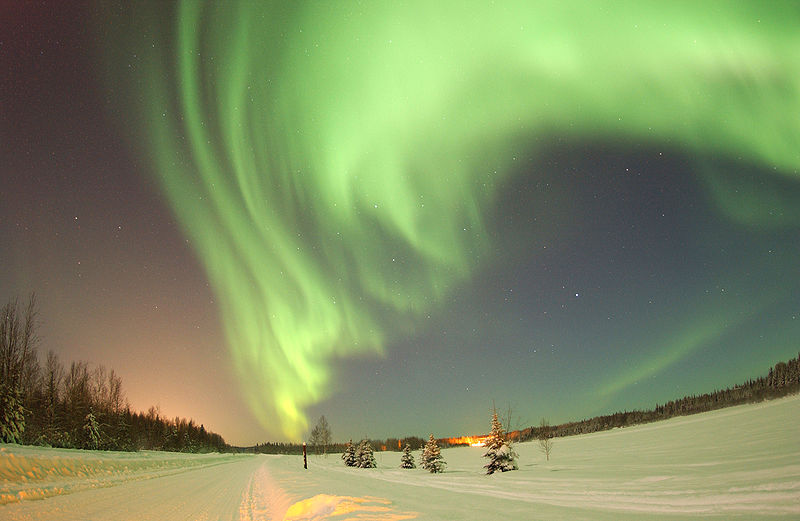Solar Flares
Sunspots
When Galileo turned his telescope towards the Sun, he shocked the established order by discovering blemishes, or spots, on its surface. The Sun was clearly not a perfect orb of heavenly light and fire, as had always been taught. The spots also changed their position and size from day to day. We now know that sunspots are relatively cold areas on the surface of the Sun (usually about four thousand degrees Celsius), and are caused by disturbances in the Sun’s magnetic field. Since the Sun is made from circulating gas and plasma, and is therefore entirely fluid, the equator rotates much more rapidly than areas near the poles, which thoroughly stirs up the material. This also causes the Sun’s powerful magnetic field to become twisted and deformed, and these disturbances are what cause sunspots to appear. Sunspots follow an eleven year cycle (roughly), which determines both the number of spots, and their location.

The cycles are not constant, however, as can be seen in the diagram. In fact, in the late 17th century, the sunspot cycle faded away almost entirely – an event known as the Maunder Minimum (after E. Walter Maunder, of Greenwich Observatory). The current cycle (Edit: by 2012, the cycle was definitely back on track, and approaching maximum) has been very slow to start – http://www.spaceweather.com has daily records and commentary on how remarkably quiet the Sun has been for the last few years. However, it is important to remember that this is only unusual in the very short term – the Sun has been shining for billions of years, and has always been a complex dynamic system. Solar astronomers have been recording the Sun’s activity for centuries, and the records show exactly what we expect. Like all natural cycles, it is not perfect regular: Both the timing and intensity hover around an average figure, but it is only an average over time. The next time a doomsday prophet points out that the current cycle is months behind schedule, and uses this as evidence that the Sun is about to do something terrifying, you can join us as we point and laugh at his ignorance!
Prominences
The Sun’s writhing magnetic field does more than just stir up sunspots, however. Sometimes localised regions of the magnetic field will twist and rise up from the Sun’s surface, arcing upwards into gigantic loops many times larger than the Earth. Superheated gas and plasma are drawn up and flow along these lines, creating vast hoops of fiery solar material arcing through space. While these prominences aren’t usually visible without specialised filters, if they happen to occur on the edge of the Sun (from our point of view) during a solar eclipse, they stand out boldly as weird pink circular flames. Because they have the same origins, they are about as common as sunspots, and often appear in the same place. They come in two varieties: Quiescent prominences which hang above the Sun for days on end, and Eruptive prominences which burst upwards in mere hours. The photograph was taken from Skylab in 1974, and is still one of the largest and most violent prominences on record.
Flares
Solar Flares are rather more energetic than Prominences. Taking only minutes to rise to full size, and decaying within an hour, they occur when twisted magnetic lines break and reconnect. This releases huge amounts of energy in the form of X-Rays, high energy subatomic particles and Ultraviolet Light. The X-Rays and UV light reach earth in under eight minutes, while the particles take from hours to days to reach us, depending on the intensity of the flare. Solar flares can disrupt the earth’s protective ionosphere (affecting long-range radio broadcasts), damage satellites, induce surges in power transmission lines. Worst of all, they can injure or kill astronauts who lack the protection of Earth’s atmosphere and magnetic field. Fortunately, there is usually sufficient warning for them to retreat to shielded locations within their spacecraft or station.
CME

If a magnetic reconnection is violent enough, it can actually blast large amounts of material from the Sun’s ionised surface out into space. This is called a Coronal Mass Ejection (CME). This material rushes out into space at the speed of the Solar Wind (several hundred kilometers per second), until it either collides with a planet or dissipates into the interstellar medium. Of course, the impact isn’t as dramatic as it sounds – it is only extremely thin gas, after all. But it’s high temperature and electrical charge do create interesting effects: The Aurora Borealis and Aurora Australis. The material is easily swept up by the Earth’s magnetic field and directed towards the poles. When it collides with the upper atmosphere, it glows to create the beautiful and ghostly displays seen in the extreme northern and southern polar latitudes.



